Final report for LNC14-357
Project Information
Many organic and low-input farmers in the Upper Midwest are using high tunnels (hoop houses) to extend the season for tomato production. We are using participatory research methods to evaluate tomato varieties for agronomic traits, disease resistance, flavor and quality for local and regional markets in the North Central Region. We compared tomato variety performance in high tunnels and open-field management, and developed a network of farmers who are evaluating varieties in on-farm trials. We assessed quality and flavor by using a combination of farmer evaluations, research staff evaluations and Madison area chef evaluations, in addition to several public taste tests at field days and other events.
The dramatically higher yield in the high tunnel was due to both an extended season and substantially lower foliar disease incidence in the high tunnel environment. Despite the generally held opinion that modern varieties are higher yielding and more disease resistant than heirlooms, while heirlooms are more flavorful, we found more variation among varieties within these groups than between them. In addition to our findings on tomato variety performance in the upper Midwest, we have improved our participatory trialing methodology to more meaningfully involve farmers and other experts in variety trialing research, and created a participatory trialing network for tomatoes and other crops in the upper Midwest.
- Conduct organic and low-input IPM field trials investigating selection of tomato varieties for optimal economic and environmental sustainability on two research stations and on 6 participating farms.
- Characterize varieties with acidity, Brix and nutritional measurements, and identify potential correlations with quality and flavor.
- Evaluate flavor for each variety with a panel of chefs currently sourcing local products.
- Provide data for breeders, researchers, farmers and seed companies to identify both promising varieties and traits needing improvement for the NCR.
- Develop a network of farmers, extension specialists and chefs interested in participatory research.
- Create an online database that will be easy for farmers to both access and contribute to, following the model of successful citizen science projects and participatory plant breeding trial methodology
Cooperators
Research
Objective 1. Conduct organic and low-input IPM field trials investigating selection of tomato varieties for optimal economic and environmental sustainability on two research stations and on 6 participating farms.
Varieties
Plant breeders, seed companies and farmers submitted varieties for the trial. Varieties were selected based on purported high quality for fresh eating, novelty, adaptation to organic environments and lack of previous trialing in the upper Midwest. Varieties were grouped by market class, color, growth habit and breeding type (F1 or open pollinated, OP). For the purpose of analysis, we grouped varieties by their genetic background, with the 'heirloom' class having 100% heirloom variety parentage, the 'slicer' having 100% modern variety parentage and 'crosses' having 50% modern and 50% heirloom parentage, generally with the appearance of a smaller slicer. We trialed 16 varieties in common from 2014 to 2016 (Table 1), with over 20 varieties present each year, including new breeding lines each year from collaborating breeders. All seed entries were either certified organic or verified as untreated.
Table 1: Varieties present in all three years of field and high tunnel trials
|
Variety Name |
Breeder/Seed Company |
Market Class |
|
A6 |
Craig Grau |
Heirloom |
|
Big Beef |
Johnny’s Selected Seed |
Slicer |
|
Caiman |
Vitalis |
Slicer |
|
Defiant |
Johnny’s Selected Seeds |
Slicer |
|
Garden Gem |
Harry Klee, University of Florida |
Cross |
|
Garden Treasure |
Harry Klee, University of Florida |
Cross |
|
Gary’o Sena |
Keith Mueller, KC Tomatoes |
Heirloom |
|
Genuwine (Heirloom Marriage) |
Ball-PanAmerican |
Heirloom |
|
Medford |
Territorial |
Slicer |
|
OSA404 |
Organic Seed Alliance |
Cross |
|
OSA405 |
Organic Seed Alliance |
Cross |
|
Perfect Flame (Heirloom Marriage) |
Ball-PanAmerican |
Heirloom |
|
Plum Regal |
Bejo Seeds |
Slicer |
|
Purden’s Purple |
High Mowing |
Heirloom |
|
Tang |
High Mowing |
Slicer |
|
UFL1 |
Harry Klee, University of Florida |
Cross |
Experimental design
All trial varieties were grown at WMARS on land certified by Midwest Organic Services Association (MOSA) since 2008. The hoop house was built in the winter of 2013-2014 on a level area oriented north-south with the tomato beds running east-west in the direction of the prevailing winds. The outdoor tomato field was located 30 feet west of the hoop house with identical beds also oriented east-west. The hoop house and field areas were roughly 32 × 88 feet each in dimension. In 2015 and 2016 a field trial with the same varieties was also conducted at the Rock County Extension Farm, following the same experimental design and protocols of the WMARS field trial.
Within each environment, trials were conducted as a completely randomized design with two replications of three-plant plots of each variety in each environment and four replications of the check varieties, Big Beef and Pruden’s Purple in each environment. Big Beef is a common hybrid cultivar among organic farmers and is valued for its relative consistency and productivity. Pruden’s Purple is a Brandywine-type heirloom that is also very commonly grown by organic farmers and gardeners in the region. Within the rows plants were spaced two feet apart (0.6m), and the beds measured 5 feet (1.5m) from bed- center to bed-center, with two foot (0.6m) aisles. Three-plant plots were considered the experimental unit for analysis.
The total area and number of plants was limited by the dimensions of the hoop house. The decision was made to favor testing more varieties over increasing replication of a few varieties because we were interested primarily in differences among management systems and genetic backgrounds rather than pairwise comparisons of specific variety means.
Management
A cover crop of winter rye was used overwinter before the tomato trial each year. The cover crop was incorporated, and compost and pelleted chicken manure were added to achieve a total rate of 150lbs N / acre according to recommendations for tomato production. Transplants were produced under organic management. Beds were slightly mounded, laid with drip irrigation and covered in black plastic mulch. Straw mulch was used to control weeds in aisles. Hoop and field plants received roughly 0.75–1.5 inches of water per week, with two waterings per week, tapering down starting at peak harvest as recommended to encourage ripening. Rainfall was monitored and field tomatoes were also drip irrigated with 0.75–1.5 inches of water per week when rainfall did not provide sufficient water. Hoop house plants were trellised using tomato clips to guide the plants up lengths of twine attached to cross-beams. Field tomatoes were trellised using t-posts every 3–4 plants and a basket weave with tomato twine. Indeterminate tomatoes were pruned according to convention, with 2–3 leaders established
Tomatoes were harvested weekly from mid July to mid October at WMARS, and three times from mid-September to early October at Rock County. At each harvest, tomatoes were sorted into “marketable” and “unmarketable” categories. Any fruits damaged by splitting, disease, insects, rodents or weather were considered unmarketable. Natural cat-facing on heirlooms or small dry cracks due to rapid growth were still considered marketable. Total weight and number of marketable tomatoes were recorded for each plot, as were total weight of unmarketable tomatoes and causes of damage. Perfectly ripe tomatoes were put aside for flavor evaluation and flavor components analysis.
Disease incidence and severity were measured three times in each year in each environment. Severity measurements were based on nearest percentage estimates, in 5% increments (0–100%), of leaf area covered with disease. Plants that received 100% ratings were completely dead. Area under the disease progress curve was calculated for each variety in each environment using July 1, with a disease incidence of 0%, as the first data point.
Statistical analysis
Data were analyzed with the goal of characterizing management effects, genotype × environment interactions and genetic variation for specific traits of interest (i.e. yield, disease, and quality components). Analysis of variance (ANOVA) was performed for all traits of interest. A fixed effects models was created using year, management, class, variety within class, and their interactions as sources of variation.
Objective 2. Characterize varieties with acidity, Brix and nutritional measurements, and identify potential correlations with quality and flavor.
Acidity is measured as titrateable acidity and converted to citric acid (CA) equivalents, as this is the principal organic acid in tomatoes. Soluble sugars are measured in ˚Brix. ˚Brix and CA were evaluated on all tomato plots from West Madison Agricultural Research Station twice during the growing season, and separately on each sample used for flavor evaluation. Tomatoes were frozen over night and then thawed to extract the juice for both analyses. ˚Brix levels were tested using a digital refractometer. Acid content by volume was measured using an automated titrator. pH was also measured for each tomato juice sample, though it was of lesser interest than titrateable acidity, since the latter measures acidity by volume, thereby giving a more accurate indication of how acid is perceived as a flavor. During tasting evaluations (described below) chefs and research staff were asked to rate flavor intensity and the strength of different flavor components, and this was used to correlate ˚Brix and CA measurements with perceived flavor. ANOVA was performed on ˚Brix and CA and correlation tests were used to determine the relationship between ˚Brix and CA and the perception of sweetness and acidity.
Objective 3. Evaluate flavor for each variety with a panel of chefs currently sourcing local products.
Tomato varieties were first evaluated by members of the research crew after a simple training exercise to allow the recognition and scoring of different flavor attributes. These included sweetness, acidity, saltiness, bitterness and umami. Color and texture were also rated by the crew. A mixed model analysis of variance was used to analyze data from tastings, with variety as a fixed effect, and taster, year and location as random effects to determine which factors were most important in differentiating varieties. Using the variety LS means calculated from the ANOVA, principal component analysis (PCA) was used to visualize the relationship among varieties using their entire flavor profile. These results were used to select a subset of varieties to be evaluated by participating chefs. Variety LS Means were also used to test the correlation between flavor attributes and laboratory measurements described above.
Chefs participated in a similarity-based method of descriptive analysis known as “Projective Mapping.” There is a quantitative component based on the distance samples are placed from each other and a qualitative descriptive component. Chefs independently tasted each sample and place the samples on the mapping sheet according to their perception of similarity and dissimilarity. Once placed, chefs wrote the words they associated with a variety’s flavor and texture directly on the map. Analysis of the chef tasting data is done using Multiple Factor Analysis (MFA) to produce a consensus map of how chefs view the different varieties. After completing the mapping exercise, chefs evaluate the varieties again, this time from a hedonic perspective. Questions like “would you by this for your restaurant?” “how would you use this” and “what is the best trait of this variety?” helped assess the chef’s preferences.
Objective 4. Provide data for breeders, researchers, farmers and seed companies to identify both promising varieties and traits needing improvement for the NCR
Data from these trials was summarized and distributed to contributing breeders, farmers, and chefs by email, and to the public online. Participating breeders were contacted to follow up on any questions and to request feedback on reports. We identified several promising breeding lines and varieties that have good performance in the upper Midwest for productivity and flavor. We are currently writing an extension bulletin primarily for farmers in the upper Midwest, summarizing the data from three years of on-station and on-farm research.
Objective 5. Develop a network of farmers, extension specialists and chefs interested in participatory research.
In 2015, we switched to a data collection format developed by participating farmers and a flexible trialing format designed to collect information that farmers would like to know from their peers about varieties. This has led to increasing numbers of farmers participating and a better rate of return for datasheets. We had five participating farms in 2015, 15 farms in 2016 and 20 farms in 2017. We have worked to develop a method of participatory trialing that is accessible and takes advantage of the particular expertise of the farmers and the researchers.
In our pilot year of 2014, we distributed data sheets that were fairly simple, which asked farmers to rate each variety on a scale of 1-5 for early vigor, disease resistance, earliness (for harvest), yield, marketable yield, and marketability. Of the 10 farms involved in the on-farm pilot project, which included tomatoes and other crops, we got one data sheet back. So we met with the farmers involved to work out how to make the data collection more manageable and more relevant. We asked the farmers what kind of information they want in order to make decisions about growing a variety and what they would like to know from other farmers about varieties in the trial. Farmers were most interested in marketability and quality, and while productivity was important, as long as varieties produced reasonably well it wasn’t the key trait they were looking for. We came up with a list of questions they would ask other farmers about varieties, and this became our data sheet for the 2015 year. This datasheet included: Would you grow this again? How marketable is it? What did you think of the flavor? Productivity? Disease or pest issues? What was the strongest point? Any major flaws? What was the Best/Worst Variety?
Farmers have developed, over many years of experience, an ability to assess varieties holistically and we want to bring that expertise to breeders so that they are able to focus on the most important elements for direct market growers. Both the breeders and the farmers felt that this assessment was more useful, combined with more detailed data from the research station trials on the relative performance of different varieties.
We have also changed the format of chef evaluations based on feedback from chefs, which has increased the number of chefs participating in Madison. We have a core group of four chefs who have been part of the project for 3 years, and another 4 that have started attending regularly in 2016. The initial year’s flavor evaluations were done with 1-5 scales for different flavor components. While quantitative scales allow each variety to be compared to others for a number of flavor characteristics, the data sheets were time consuming and not very interesting to the chefs. Shifting to a similarity-based evaluation format, described above, allowed the chefs to evaluate only the most important attributes of each variety and intuitively compare varieties. The more intuitive format combined with qualitative descriptions worked well and conveyed much more information to chefs, rather than the 5-point scale, which many chefs found arbitrary and uninformative.
Objective 6. Create an online database that will be easy for farmers to both access and contribute to, following the model of successful citizen science projects and participatory plant breeding trial methodology
We have developed a custom instance of the cassavabase breeding database in collaboration with the Boyce Thomson Institute in Ithaca, NY. We are currently in the last phases of testing this database before making it available to participants to access through a web interface. We have collaborated with Nicolas Enjalbert of Seedlinked to develop an online platform for coordinating on-farm trials and entering on-farm trial data easily through an online interface. We are testing this in the 2018 season with participating farmers.
Objective 1. Conduct organic and low-input IPM field trials investigating selection of tomato varieties for optimal economic and environmental sustainability on two research stations and on 6 participating farms.
Over the three years of the trial, the high tunnel marketable yield was 41% higher than the field marketable yield, across all varieties (Figure 1). This difference was primarily due to greater disease in the field (Figure 2), including septoria, early blight, bacterial speck (in 2015) and extremely rainy conditions (in 2016). Varieties showed some differences in susceptibility to septoria and early blight, the two major foliar diseases, but these differences were much smaller than the effect of the management system (hoop house vs. open field). The class (heirloom parentage, modern parentage, and crosses) did not have a significant effect on yield (Fig 3) or disease resistance (Fig 4), suggesting that the perception that tomatoes with heirloom genetics are lower yielding and more disease prone may not hold for all varieties in this category, and that there is more variation within these market categories than between them.
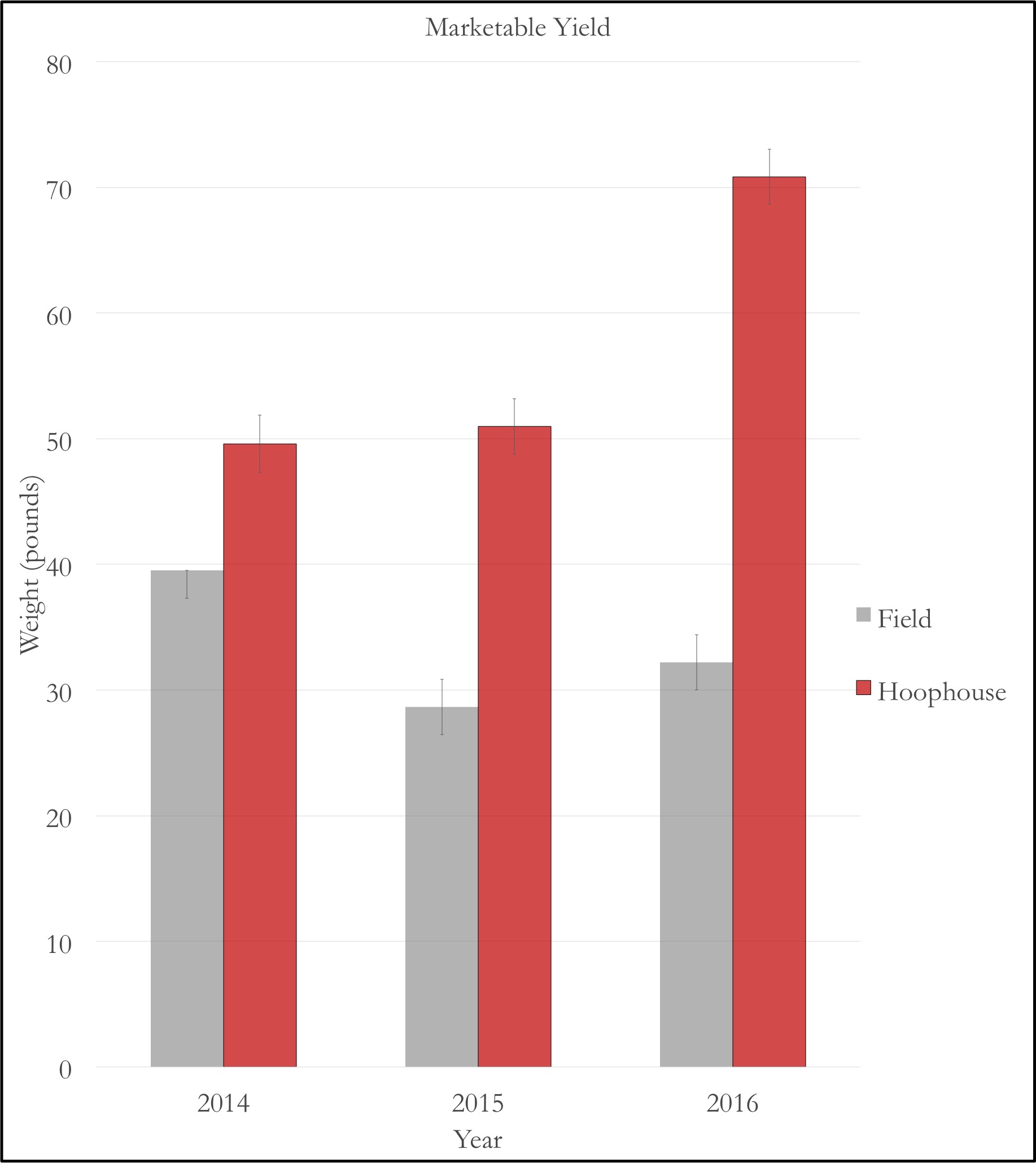
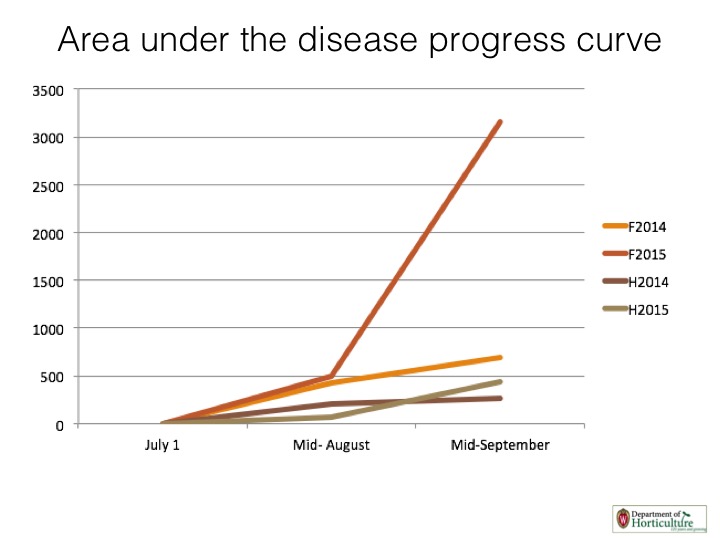
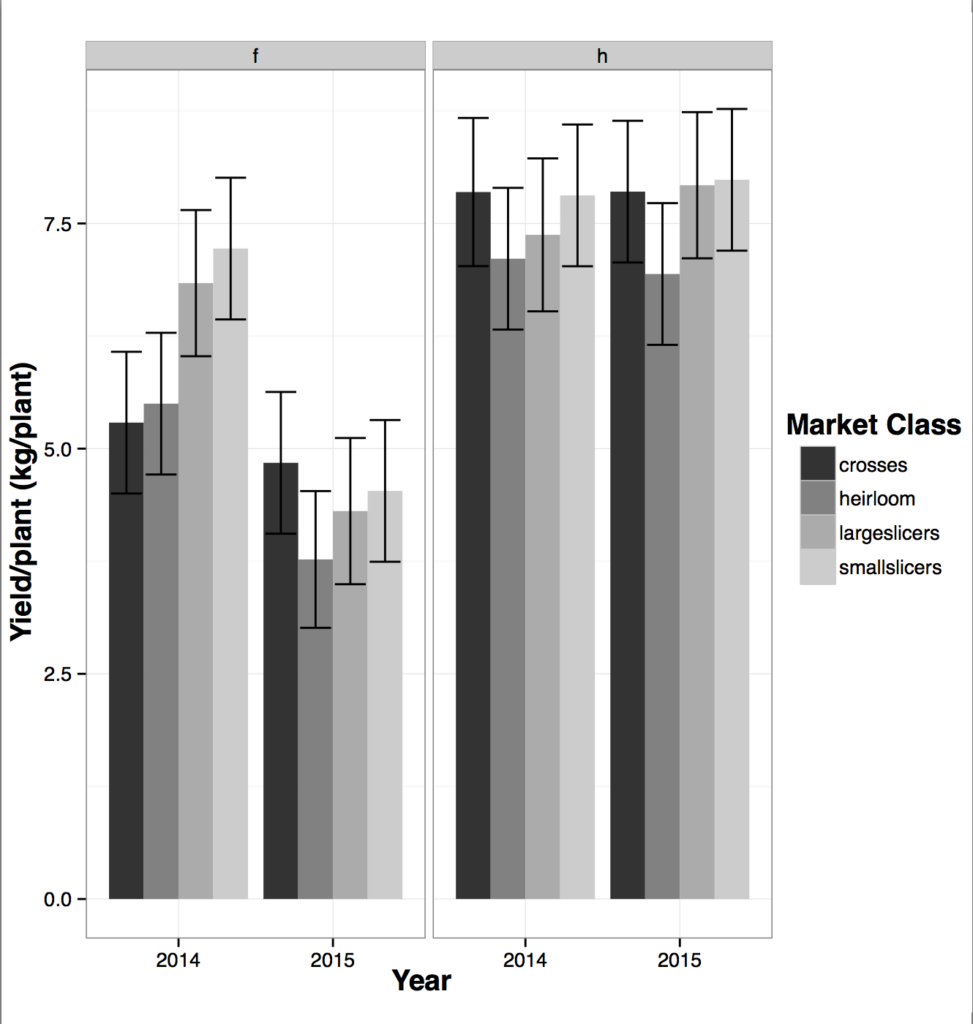
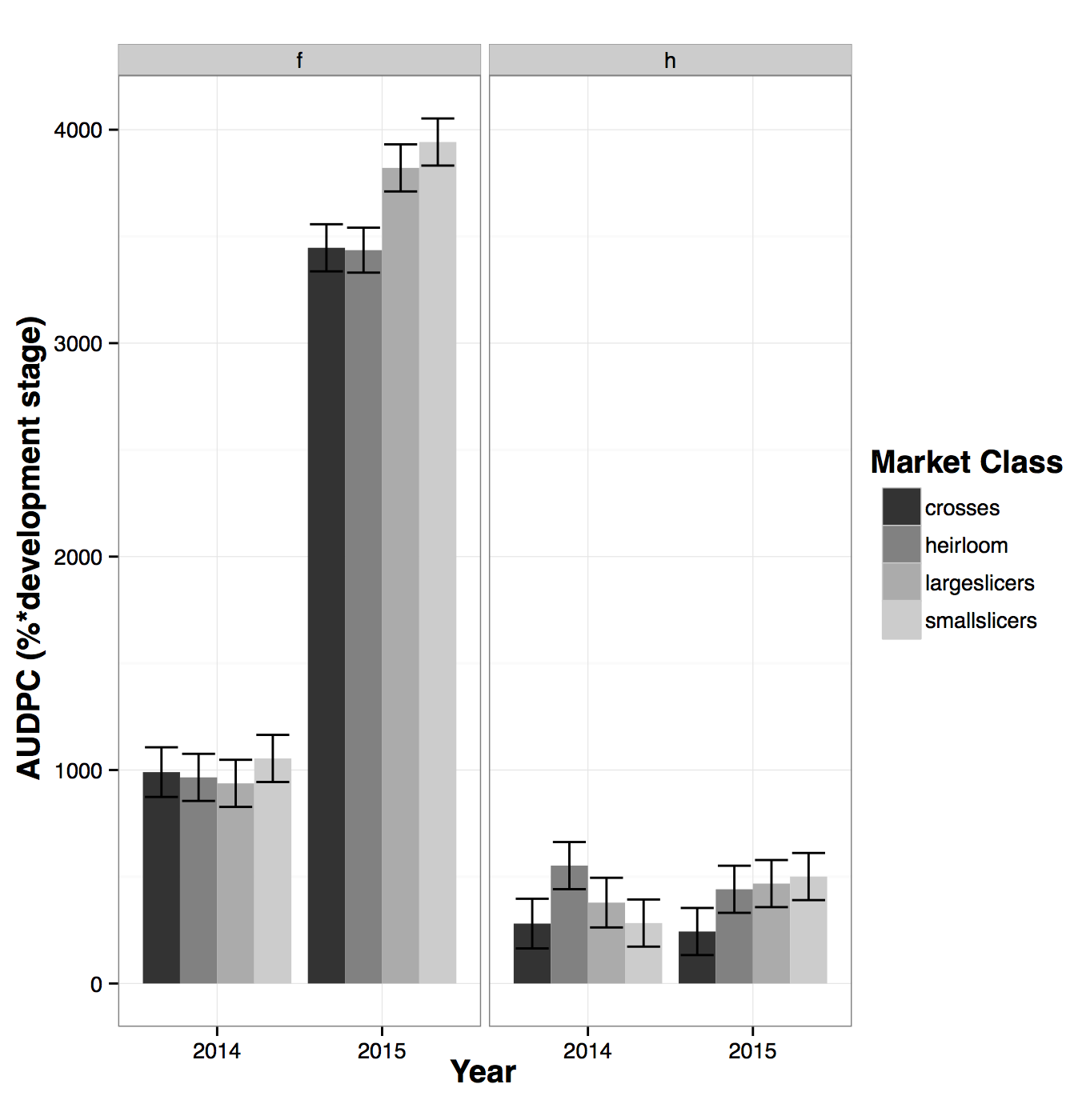
Summaries of data from these trials is available online at dawson.horticulture.wisc.edu
Objective 2. Characterize varieties with acidity, Brix and nutritional measurements, and identify potential correlations with quality and flavor.
We completed the on-station measurement of ˚Brix and acidity, as well as the flavor evaluations by chefs and research staff. The ratio of ˚Brix to CA was negatively correlated with chef's perceived flavor intensity (Figure 6), in agreement with other studies looking at flavor intensity in tomatoes. The varieties with heirloom parentage were a similar size to the modern large slicers but had ratios more similar to modern small slicers and crosses of heirlooms and modern varieties. This is expected, as many tasters perceived the heirloom parentage, small slicers and crosses (which tended to be smaller in size) as having good flavor intensity. CA content did not differ significantly between high tunnel and field production, while ˚Brix was higher on average in the hoop house. Varietal differences were significant, and contributed more to total variation in sugars and acidity than management. Correlations between ˚Brix, CA and flavor components were also promising. We found that the ˚Brix was positively and significantly correlated to perceived sweetness (r = 0.65) and that CA was positively and significantly correlated to perceived acidity (r = 0.70) (Table 2). The laboratory analyzes, if properly automated and high throughput, could potentially be used as a screening tool to help choose a subset of varieties most likely to have good flavor for further evaluation by a panel.
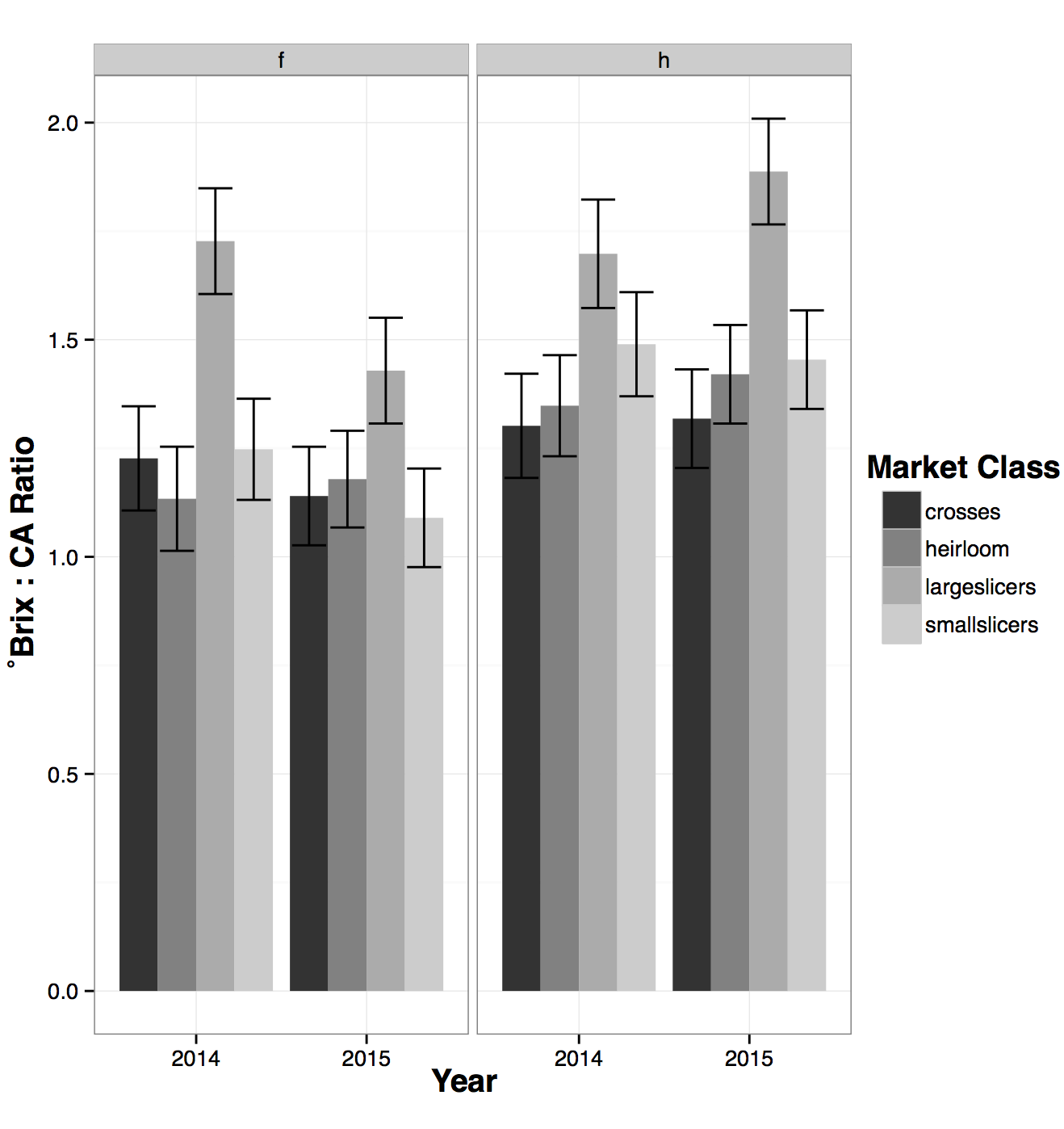
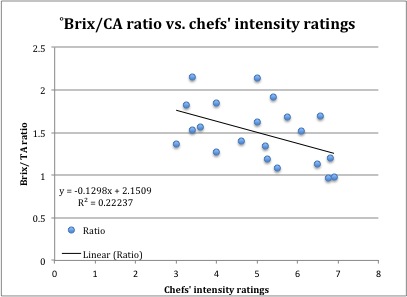
Table 2. Correlation between ˚Brix, CA and flavor components assessed by crew tastings. p-values from tests of significance are above the diagonal, r (correlation) is shown below the diagonal.
| appearance | texture | sweetness | acidity | bitterness | umami | intensity | overall | ˚Brix | CA | ratio | |
| appearance | 0.0034 | 0.0131 | 0.0014 | 0.9047 | 0.0463 | 0.0026 | 0.0016 | 0.2528 | 0.0249 | 0.0286 | |
| texture | 0.50 | 0.0001 | 0.0005 | 0.1105 | 0.0069 | 0.0001 | 0.0000 | 0.3639 | 0.1166 | 0.1026 | |
| sweetness | 0.43 | 0.63 | 0.0000 | 0.0017 | 0.0000 | 0.0000 | 0.0000 | 0.0000 | 0.0012 | 0.0627 | |
| acidity | 0.53 | 0.58 | 0.71 | 0.6784 | 0.0000 | 0.0000 | 0.0000 | 0.0168 | 0.0000 | 0.0000 | |
| bitterness | 0.02 | -0.28 | -0.53 | -0.07 | 0.2841 | 0.3061 | 0.0541 | 0.0529 | 0.6663 | 0.7279 | |
| umami | 0.35 | 0.46 | 0.66 | 0.68 | -0.19 | 0.0000 | 0.0000 | 0.0467 | 0.0045 | 0.0123 | |
| intensity | 0.51 | 0.63 | 0.84 | 0.91 | -0.18 | 0.78 | 0.0000 | 0.0020 | 0.0000 | 0.0009 | |
| overall | 0.53 | 0.74 | 0.91 | 0.83 | -0.34 | 0.76 | 0.94 | 0.0025 | 0.0006 | 0.0135 | |
| brix | 0.20 | 0.16 | 0.65 | 0.41 | -0.34 | 0.35 | 0.52 | 0.51 | 0.0001 | 0.3201 | |
| CA | 0.39 | 0.28 | 0.54 | 0.69 | -0.08 | 0.48 | 0.68 | 0.56 | 0.64 | 0.0000 | |
| ratio | 0.38 | 0.29 | 0.33 | 0.66 | 0.06 | 0.43 | 0.55 | 0.43 | 0.18 | 0.85 |
Objective 3. Evaluate flavor for each variety with a panel of chefs currently sourcing local products.
Crew and chef evaluations of flavor were largely in agreement. Slicers had lower flavor intensity than crosses or heirloom genetic backgrounds (Figure 7). Overall flavor appreciation was strongly correlated to perceived flavor intensity for the crew evaluation (r=0.91), (Table 2 and Figure 8) and for the chef evaluation (Figure 9). The results of the PCA analysis of the crew and the projective mapping chef flavor evaluations in 2016 are shown in Figures 10 and 11. In each figure, the flavor components are plotted as arrows in the direction of increasing values of that component and varieties are plotted in relationship to these flavor components based on their scores for each component. Breeding line 45L23 from independent breeder Keith Mueller was a crew and chef favorite, with high flavor intensity and high sweetness and acidity. Garden Gem, a cross between a modern and heirloom parent from Harry Klee at the University of Florida was also a favorite, with a similar flavor profile to 45L23. Breeding line P322-1-2-1, a cross between Indigo Rose and an heirloom variety from Jim Myers at Oregon State University also had a good flavor profile with high acidity. It was rated as more savory (umami) by the crew than by the chefs. OSA 404 is another breeding line with good flavor, not quite as intense as the others mentioned but with good balance. It is a cross of heirloom and modern parents from the Organic Seed Alliance which has been selected for foliar disease resistance and good flavor.
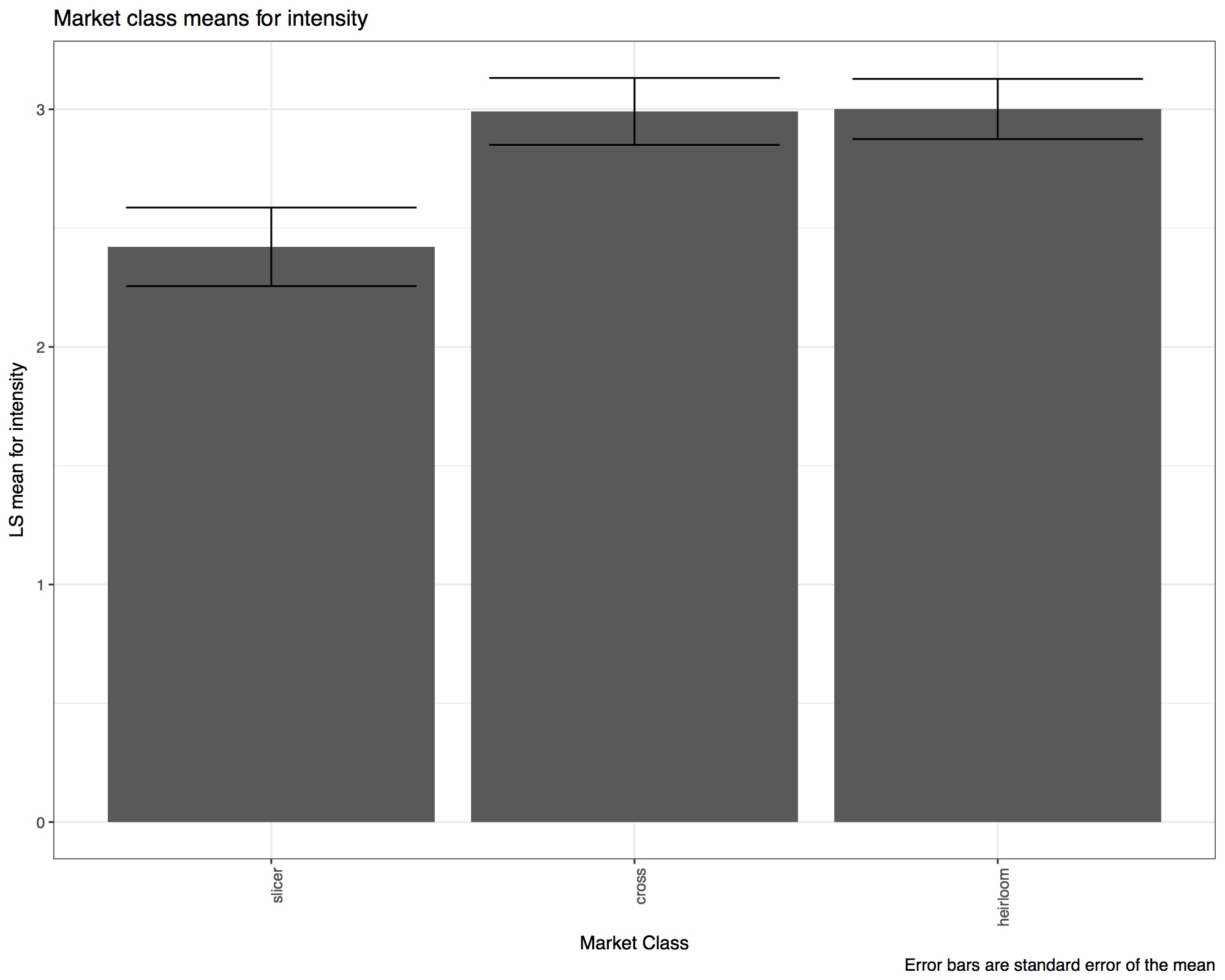
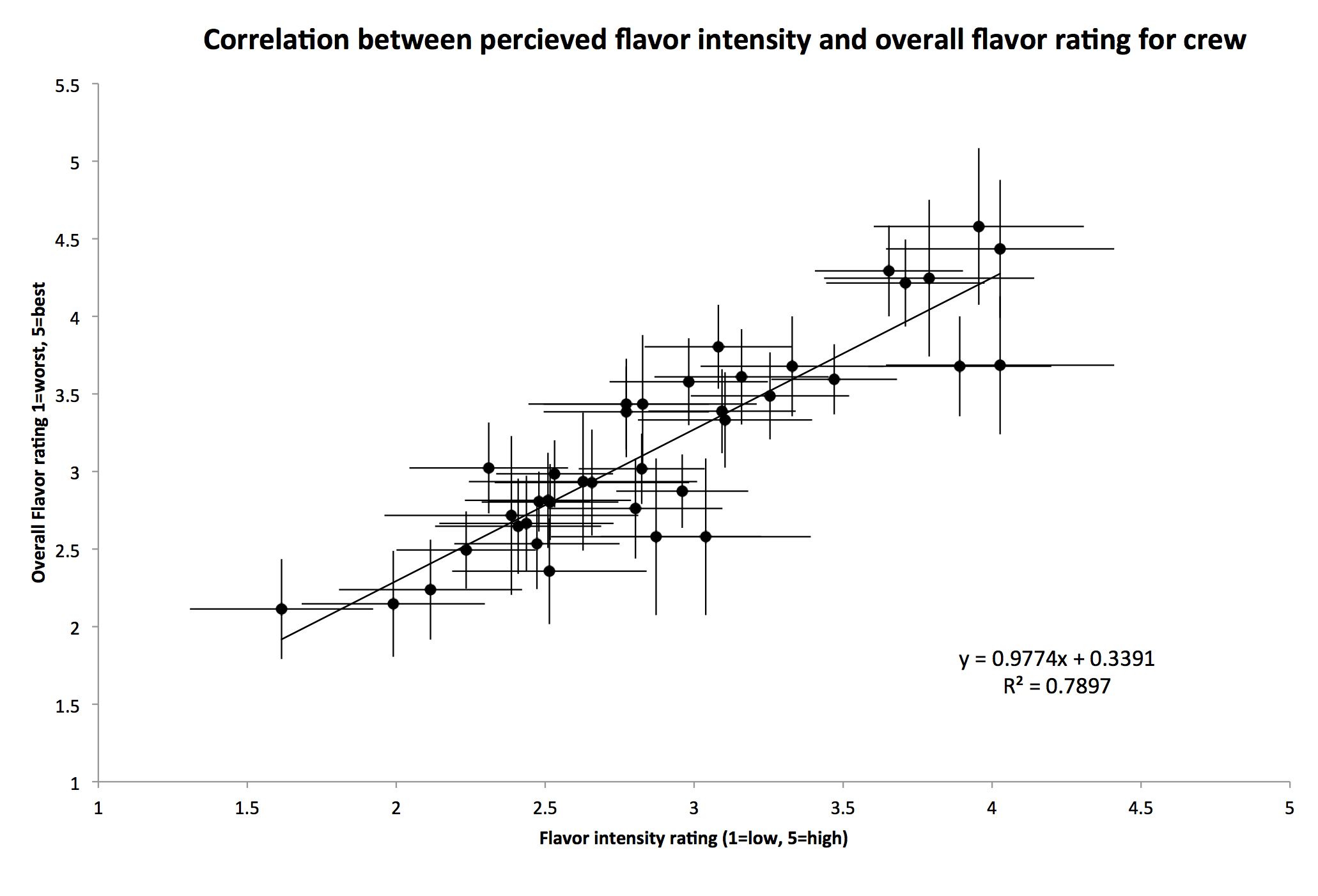
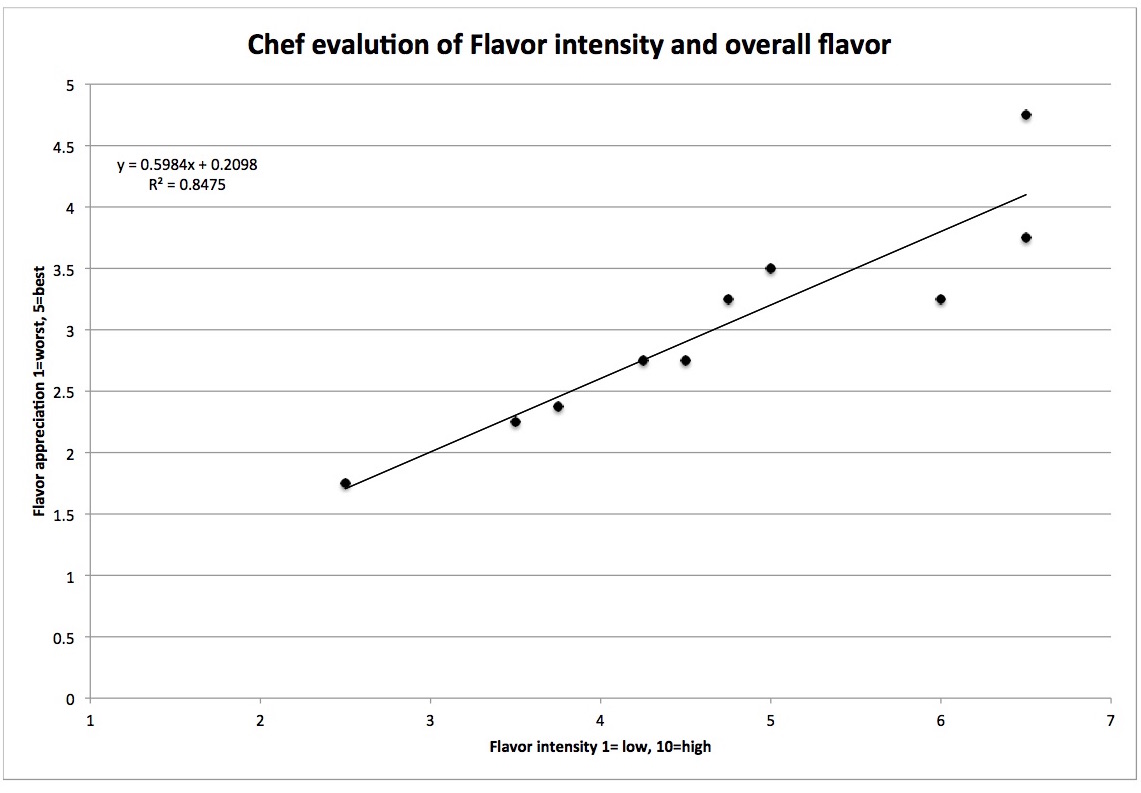
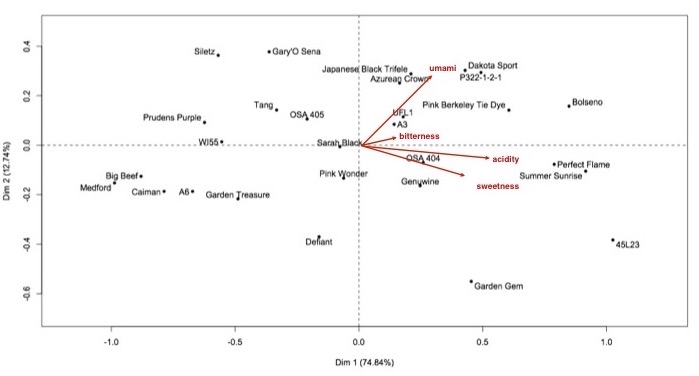
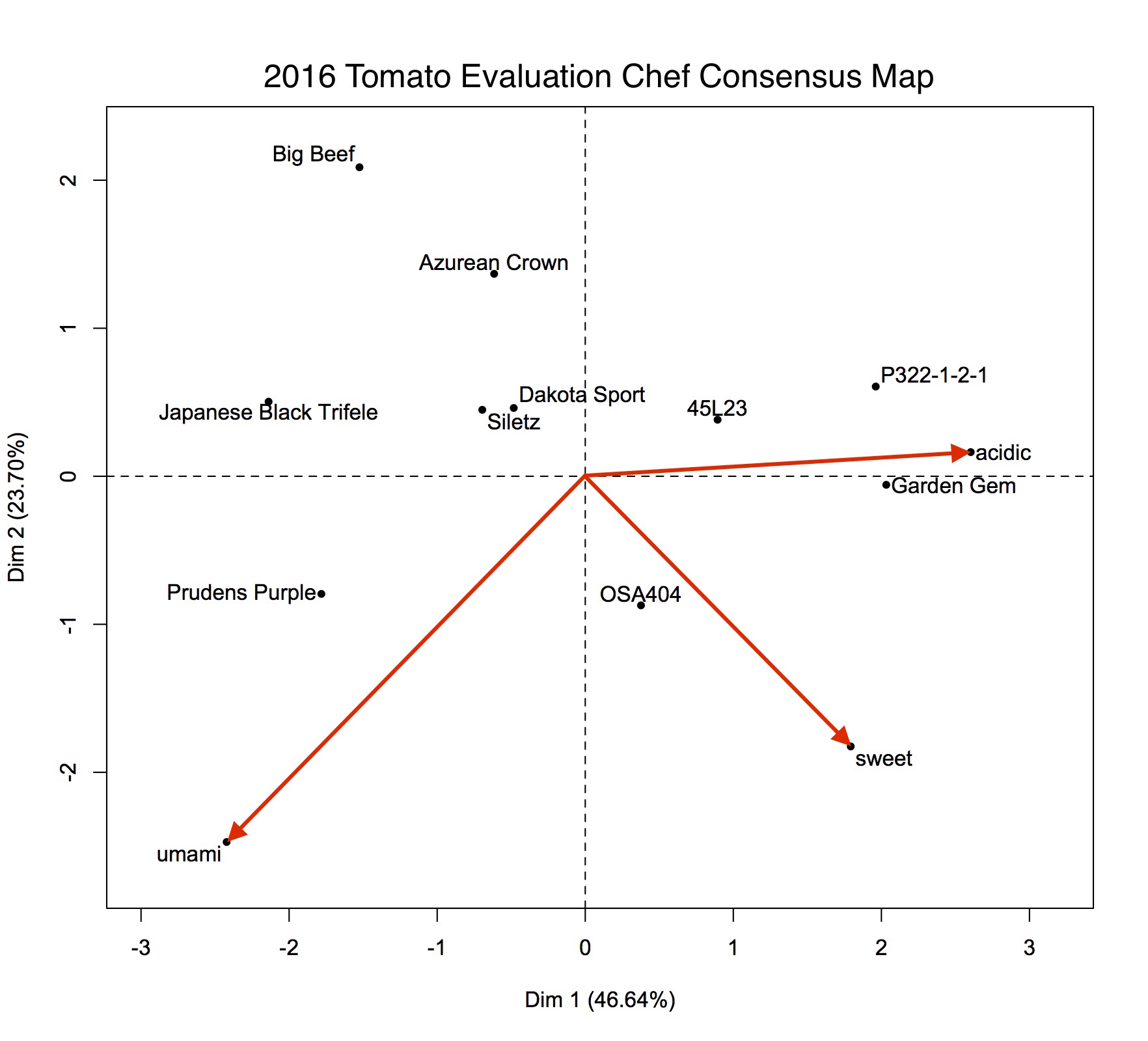
Objective 4. Provide data for breeders, researchers, farmers and seed companies to identify both promising varieties and traits needing improvement for the NCR
While the core set of varieties in the on-station trials for this project have remained constant due to the need for multiple year comparisons, we have received new breeding lines from several independent, university and seed company breeders based on results from the trials and farmer evaluation and feedback. These lines are currently in screening trials at the research station and the best ones will move to on-farm trials with the Seed to Kitchen Collaborative project. In the first few years, our screening trials had a wide range of quality and production traits, but we have seen a shift in varieties that breeders are contributing, with an increase in both quality and adaptation to the upper Midwest. We have used trial information to also identify potential parental varieties, particularly from heirloom backgrounds, for developing new varieties with quality and productivity in organic systems in the upper Midwest. These parents are being crossed for selection on-station and on-farm as part of a newly funded NC SARE project, Improving farmer options for sustainable and profitable direct-market tomato production and high tunnel management in the upper Midwest.
Objective 5. Develop a network of farmers, extension specialists and chefs interested in participatory research.
We started with 5 farmers trialing tomatoes in 2015, and had 14 in 2016 and 20 in 2017. Collaborating with extension educators in several counties in Wisconsin has helped us recruit farmers, hold events and field days and maintain an on-the-ground presence in counties distant from Madison. We also have farmers participating in Minnesota, Michigan and Illinois and are working to build our networks in those states. The on-farm trials started in this project have grown over the past 4 years into the Seed to Kitchen Collaborative, which involves 12 different vegetable crops and 70 participating farms. The Seed to Kitchen Collaborative aims to be an ongoing network supporting on-farm variety trials and variety selection for quality and performance in organic and low-input systems in the upper Midwest. We have also developed a national collaborative network of similar trialing initiatives and are conducting a pilot trial coordinated across these different trialing sites in 2018.
Objective 6
The database for on-farm trials and participatory research will extend beyond this project to include other species in future years and will contribute to the development of farmer research networks. Farmers and breeders will be able to access this database through a dedicated website with an R shiny app interface by the end of the 2018 season. This allows users to run simple analyses through drop-down menus without needing to know the R programming language. We have also collaboratively helped to develop a project called SeedLinked (www.seedlinked.com, led by Nicolas Enjalbert) through our work on on-farm trialing with project and together with Dr. Enjalbert (PI) have received a USDA SBIR grant that will develop Seedlinked as an on-farm trial coordination and data collection platform. We are piloting the SeedLinked application with on-farm trials in the 2018 season.
Our trials have shown that the management system (high tunnel vs field) is the most important contributor to differences in marketable yield and disease incidence of the factors we examined. High tunnel production resulted in a 41% increase in marketable yield averaged across all varieties and years. Variety choice also has an impact on marketable yield and disease incidence, however, we did not find significant differences between classes (heirloom parentage, modern parentage or crosses). There was more variation among varieties within these classes than between them. We did find that while marketable yield consistently increased when varieties were cultivated in a high tunnel, secondary traits of importance were different between the two systems. Field production requires varieties with good resistance to cracking and foliar diseases while high tunnel production requires varieties which are not as susceptible to blossom end rot and blossom abortion under heat stress. These suites of secondary traits are important enough to merit separate breeding programs when developing varieties for field or high tunnel production in the upper Midwest.
We found that laboratory measurements of sugar (˚Brix) and acidity (Citric Acid) are correlated with perceived sweetness, acidity and overall flavor. They could be used as a screening tool to reduce the number of breeding lines or varieties for tasting by discarding ones that are unlikely to have good flavor based on their sugar/acid profile. However, a substantially higher throughput system of measurement would be needed before the laboratory measurements are faster than using tasting as a screening tool, and might only be efficient if there are many more lines to be evaluated than is reasonably feasible for a crew to taste. We found a strong correlation between sweetness, acidity, flavor intensity and preference, in agreement with previous work.
In evaluating flavor, we developed an efficient method of screening many entries with our research crew, followed by more detailed evaluation of the best lines with a group of participating chefs. The research crew is a consistent group of people over the season that can evaluate many more lines than the chefs have time to taste. The chefs bring a level of experience in using tomatoes in their kitchens, and an ability to articulate what they are tasting that can be useful to breeders. The chef and crew tastings were remarkably consistent in terms of favorites and ideal characteristics. While varieties with only modern genetic backgrounds had the least intense and least preferred flavor, many of the favorite tomatoes for flavor were crosses between modern and heirloom varieties selected for both performance and flavor. This is very promising for breeding efforts to combine exceptional flavor with other traits of importance to growers as it suggests that by paying attention to flavor, we can avoid compromising it when selecting for disease resistance or productivity and that these two important traits are not intrinsically a trade-off. However, these varieties were often on the sweet-acid side of the tomato flavor spectrum, while heirlooms often were still the best on the more savory side of the spectrum.
Our on-farm trials were successful at involving an increasing number of farmers in the evaluation and selection of tomato varieties with good performance in the upper Midwest for direct markets such as CSAs, farmers markets and restaurants. The methodology we have developed focuses on obtaining qualitative information from farmers with trials that fit easily into diversified vegetable production. Our data collection is guided by what farmers want to know about varieties from their peers, and what breeders want to know about varieties from farmers. This methodology is now being used in the Seed to Kitchen Collaborative with other crops in addition to tomatoes. More information is available at dawson.horticulture.wisc.edu.
Education
Production systems of market farms differ widely in management and environmental constraints, and this diversity makes decentralized trials and farmer participation critical to the relevance of breeding programs. Consistently, growers ask for peer-to-peer training opportunities and collaborative research and demonstration projects that involve growers and other food systems stakeholders from the beginning phases. For this reason, participatory research and extension that facilitates farmer-to-farmer learning is the most relevant approach for this group of stakeholders.
In both field seasons, we held field days at the research stations with farmers involved in trials describing their experiences on-farm and opportunities for farmers and potential end-users to participate in field evaluations and tastings. Field days included a field tour of the tomato trial and a taste evaluation at West Madison, and a field day at Rock County Extension, as well as participation in the Urban Agriculture open house for the public at West Madison.
Results from the trials were presented at farmers’ conferences in the winter each year and at a dedicated project meeting held in Madison and at a location in Northern Wisconsin each winter. Data collected from these trials was distributed to all participating farmers and plant breeders during the project and was published in a scientific publication in 2017. A second scientific publication and two extension bulletins, one on the variety trials and one on high tunnel production will be published by the end of 2018. The extension bulletin will be distributed to all participating farmers and available online.
Project Activities
Educational & Outreach Activities
Feb 6, 2017. Seed to Kitchen Meeting. The Thirsty Pagan, Superior, WI. Meeting of local chefs and farmers in Northern Wisconsin to discuss results from 2016 and set priorities for the 2017 growing season. Attendance about 25.
Jan 16, 2017. Seed to Kitchen Meeting. L’Etoile, Madison. Meeting of local chefs and farmers with plant breeders to discuss results from 2016 and set priorities for the 2017 growing season. Attendance about 25.
Jan 11, 2017. Grower Roundtable Discussion. Illinois Specialty Crops, Agritourism, and Organic Conference. Springfield, IL
Feb 11, 13, 15 2016. Seed to Kitchen Meeting. L’Etoile, Madison. Meetings of local chefs and farmers with plant breeders to discuss results from 2015 and set priorities for the 2016 growing season. Attendance about 40 across all three meetings.
Jan 27, 2016. Seed to Kitchen Meeting. Douglas County Courthouse, Superior, WI. Meeting of local chefs and farmers in Northern Wisconsin to discuss results from 2015 and set priorities for the 2016 growing season. Attendance about 25.
Jan 19, 2015. Chef-farmer-plant breeder meeting on flavor in fresh market vegetables. L’Etoile, Madison. Meeting of local chefs and farmers with plant breeders to discuss results from 2014 and set priorities for the 2015 growing season. attendance about 40.
Participation Summary:
Healy, G.K., B. Emerson and Dawson, J.C. Comparing tomato varieties for productivity and quality under organic hoop-house and open-field management. Renewable Agriculture and Food Systems.
Dawson, J.C. and G.K. Healy. 2018. Flavor evaluation for plant breeders. Plant Breeding Reviews 41: 215-262.
Theses
Hodge, T.L. 2018. Organic High Tunnel and Open Field Tomato Variety Trials for Production in the North Central Region of the United States of America. Master of Science Thesis, Horticulture, University of Wisconsin-Madison.
Healy, G.K. 2016. Tomato Variety Trials, Selection and Breeding for Regional Adaptation and Culinary Quality in Organic Systems. Master of Science Thesis, Horticulture and Agroecology, University of Wisconsin-Madison.
On-farm demonstrations
See section on project activities
Curricula, Fact-sheets, educational tools
An extension bulletin on tomato varieties and one on high tunnel production are in preparation.
Tours
August 7 2017. Tour of West Madison Organic Research Trials. National Sustainable Agriculture Coalition (NSAC) Summer Meeting. Presented high tunnel tomato trials, Seed to Kitchen variety trials, carrot and potato research plots to agricultural professionals attending the NSAC Conference. About 120 attendees.
September 1st. 2016. Vegetable Trial Field Walk. Stony Acres and Red Door Family Farm. Organized with Marathon County Extension. Attendance about 10.
2017 Growing season, Seed company visits to Seed to Kitchen trials at West Madison. Johnny’s Selected Seeds, High Mowing Organic Seeds, Vitalis Organic Seeds, Ball Seeds/Pan-American, AP Whaley Seeds, Harris Seeds
2016 Growing season, Seed company visit to Seed to Kitchen trials at West Madison: Johnny’s Selected Seeds (3 different dates), High Mowing Organic Seeds, Vitalis Organic Seeds, Ball Seeds/Pan-American, AP Whaley Seeds
2015 Growing season, Seed company visit to Seed to Kitchen trials at West Madison: Johnny’s Selected Seeds, High Mowing Organic Seeds, Vitalis Organic Seeds, Ball Seeds/Pan-American, AP Whaley Seeds
Webinars, talks and presentations
Hodge, T.L, Emerson, B., Hickey, T.P., Healy, G.K., Dawson, J.C. 2018. Tomato varieties for organic high tunnel and field systems: are separate breeding programs needed? American Society of Horticultural Sciences Annual Meeting, Washington DC, Aug1-3. Accepted oral presentation.
Dawson, J.C. 2018. On-Farm Vegetable Variety Trials and Results from the Seed to Kitchen Collaborative Indiana Small Farms Conference. Danville, IN, March 2. Attendance about 30.
Myers, J.R., Zystro, J. and Hodge, T. 2018. Taking tomatoes totally organic. Organic Seed Growers Conference. Corvallis, OR. Feb 15.
Selman, L., Wyatt, L., Meints, B. Hodge, T., Greene, K. 2018. Building Relationships from Seed to Fork. Organic Seed Growers Conference. Corvallis, OR. Feb 15.
Dawson, J.C. 2018 Tomato varieties for organic high tunnel systems Great Plains Specialty Growers Conference. St. Joseph MO, Jan 13. Attendance about 50.
Dawson, J.C. 2018 Modern Heirlooms: Developing new high-quality vegetable varieties for organic systems. Illinois Specialty Crops, Agritourism, and Organic Conference. Springfield IL, Jan 12. Attendance about 30.
Dawson, J.C., Genger, R., Becker, K. 2017. Healthy, productive, delicious: Choosing the best vegetable varieties for your farm or garden. Women Food and Agriculture Network Conference. Madison, WI, November 3. Attendance about 30.
Dawson, J.C. 2017. Extension of the Growing Season: Vegetables. Wisconsin Master Gardener Conference. West Bend, WI October 14. Attendance about 20.
Dawson, J.C. 2017. Variety Trial and Seed Selection. Half-day workshop at the Ecological Farming Association conference. Blue Mountains, Ontario. November 29. Attendance about 20.
Dawson, J.C. 2017. Quality evaluation of vegetables with farm-to-table chefs. National Pickle Packers Association Milwaukee, WI. April 20. Attendance about 60
Dawson, J.C. and G.K. Healy. 2017. Vegetable varieties: the good, the bad and the deliciously ugly. Organic Vegetable Production Conference. Madison, WI. Feb 3-4. Attendance about 150.
Dawson, J.C. 2017. Tomato variety trials for market growers. Wisconsin Fresh Fruit and Vegetable Growers Conference. Wisconsin Dells, Jan 24. Attendance 27
Healy, G.K. and J.C. Dawson. 2017. Tomato variety trials for flavor, quality and Agronomic Performance. NC SARE Farmers Forum, Illinois Specialty Crops, Agritourism, and Organic Conference. Jan 11-13. Attendance 25
Dawson, J.C. G.K. Healy and B.J. Emerson. 2016. Hoop House and Open Field Organic Tomato Trials for Production and Quality Characteristics in the Upper Midwest. Agriculture and Natural Resources Extension Conference. Oct. 20. Attendance about 20 educators.
Dawson, J.C. Hoop House and Open Field Organic Tomato Trials for Production and Quality Characteristics in the Upper Midwest. Annual meeting of the American Society of Horticultural Science (ASHS), Baltimore, MD. August 10th 2016.
Dawson, J.C. What makes local food different? Research to support direct-market vegetable growers. University of Wisconsin Plant Pathology Seminar Series March 14th, 2016.
Dawson, J.C. What makes local food different? Research to support direct-market vegetable growers. University of Minnesota Horticulture Seminar Series. Feb 24th, 2016.
Healy, G.K. and Dawson, J.C. Effects of High Tunnel vs. Field Production on Tomato Varieties. Wisconsin Fresh Fruit and Vegetable Growers Conference. January 25th, 2016. Attendance 35
Healy, G.K. and Dawson, J.C. 2015. Presentation of tomato trials and chef-farmer-breeder collaborative. Student Organic Seed Symposium. Madison, WI, August 10. Attendance about 60.
Dawson, J.C. 2015. Modern heirlooms: collaboration of farmers, chefs and plant breeders to create vegetables for local food systems. Wisconsin Local Food Network Summit. Wisconsin Rapids. Jan 30-31, 2015. attendance about 30.
Healy, G.K., Theisen, T., Reese, M., Cotter, N. and Dawson, J.C., 2015. Variety trials for direct market quality and flavor. Organic Agriculture Research Symposium. LaCrosse, WI, Feb 25-26, 2015. attendance about 30.
Posters:
Hodge, T., G.K. Healy, B. Emerson and J.C. Dawson. 2017. Tomato Varieties for Organic High Tunnel and Field Production in the Upper Midwest. Poster Presentation at the MOSES Organic Farming Conference, La Crosse, WI, Feb 24-25, 2017.
Dawson, J.C., Emerson, B., Healy, K., Hickey, T., Theisen, T. 2016. Participatory evaluation of vegetable flavor and implications for developing varieties for organic systems. Poster presentation at the Organic Agriculture Research Symposium. EcoFarm, Asilomar, CA. Jan 20.
Dawson, J.C., G.K. Healy, T. Theisen, N. Cotter, T. Hickey, B.J. Emerson. 2016. Participatory Vegetable Variety Trials and Quality Evaluation with Farmers, Consumers and Chefs. Poster at MOSES Organic Farming Conference. LaCrosse, WI. Feb 25-26.
Dawson, J.C., G.K. Healy, T. Theisen, N. Cotter, T. Hickey, B.J. Emerson. 2016. Participatory Vegetable Variety Trials and Quality Evaluation with Farmers, Consumers and Chefs. Poster at WLFN conference. January 14-15, Sheboygan, WI.
Dawson, J.C. Vegetable Variety Evaluations on Commercial Farms. Wisconsin Fresh Fruit and Vegetable Growers Conference. January 26th, 2016.
Dawson, J.C. Modern Heirlooms. Superior Public Library Seminar Series. Superior WI. Jan 26th, 2016
Dawson, J.C. Developing Taste in Vegetables. Master Gardeners Workshop. Rio, WI. April 2nd, 2016.
Dawson, J.C. Hoop Houses. Master Gardeners Workshop. Rio, WI. April 2nd, 2016.
Dawson, J.C. Wisconsin Vegetable Variety Trials. Horticulture Update. UW Extension September 16, 2016.
Workshops/field days
October 2, 2017. Variety Showcase, Portland, OR. Development of a tomato flavor lexicon and validation with participants. Organized by the Culinary Breeding Network. 500 attendees
August 24, 2017. Farm to Flavor Dinner. Event to highlight some of the best varieties from the season from the vegetable flavor project, with participating chefs. Presented the project to the public and introduced them to some of the farmers, plant breeders and chefs working to improve vegetable varieties for Wisconsin and for flavor. Keynote lecture Lane Selman, Culinary Breeding Network. 220 attendees.
August 24 2017. Organic Vegetable Variety Field Day. West Madison Agricultural Research Station. Attendance about 50.
August 12, 2017. Urban Horticulture Field Day. West Madison Agricultural Research Station. About 160 attendees. Tomato tasting event.
July 17 2017. Vegetable field day for Seed to Kitchen project and vegetable tasting. Spooner Agricultural Research Station. Attendance about 30.
Culinary Breeding Network Variety Showcase, October 3rd 2016. Portland, OR. Kitt Healy presented and sampled high-flavor tomatoes identified through our field trials, in collaboration with Jonny Hunter, one of our participating chefs. 400 attendees
September 11th 2016. Organic Vegetable Field Day West Madison Agricultural Research Station. About 50 people
September 15th. 2016. Farm to Flavor Dinner. Organized an end of season event to highlight some of the best varieties from the season (that were still available in October) from the vegetable flavor project, with chefs Tory Miller, Dan Bonano and Jonny Hunter. Presented the project to the public and introduced them to some of the farmers, plant breeders and chefs working to improve vegetable varieties for Wisconsin and for flavor. Keynote lecture by Ken Greene, Hudson Valley Seed Library. 170 attendees.
August 30. 2016. Vegetable field day for trials. Spooner Agricultural Research Station. Attendance about 12.
August 20 2016. Urban Horticulture Field Day. West Madison Agricultural Research Station. 200 attendees. Pouring rain.
Feb 3rd, 2016. Sensory Analysis Workshop. Organized in conjunction with the Organic Seed Growers Conference. Corvallis, OR.
September 8, 2015. Organic Vegetable Field Day. West Madison Agricultural Research Station. Responsible for organizing field day which presented research from eight UW Madison research programs. Attendance about 50 people.
Dawson, J.C. and Haga, E. 2015. Seed saving, hand pollination, and selection for tomatoes. Workshop at the Organic Seed School. August 9. Madison WI. Attendance about 60.
Learning Outcomes
- On-farm trialling
- Tomato varieties with adapation to the upper midwest and excellent quality
Project Outcomes
on-farm trials
tomato varieties grown